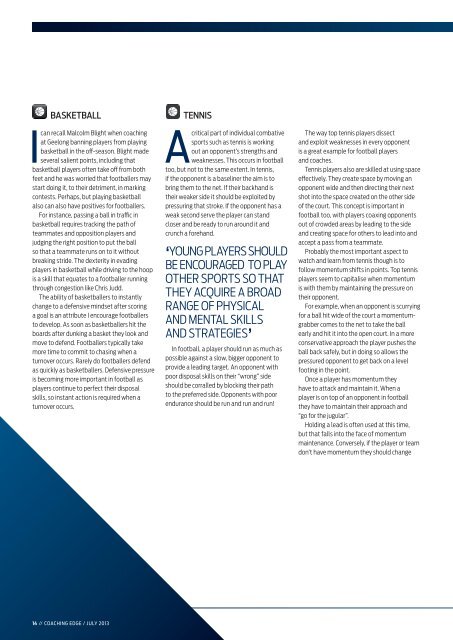Coaching Edge - AFL Community
Coaching Edge - AFL Community
Coaching Edge - AFL Community
Create successful ePaper yourself
Turn your PDF publications into a flip-book with our unique Google optimized e-Paper software.
Basketball<br />
I<br />
can recall Malcolm Blight when coaching<br />
at Geelong banning players from playing<br />
basketball in the off-season. Blight made<br />
several salient points, including that<br />
basketball players often take off from both<br />
feet and he was worried that footballers may<br />
start doing it, to their detriment, in marking<br />
contests. Perhaps, but playing basketball<br />
also can also have positives for footballers.<br />
For instance, passing a ball in traffic in<br />
basketball requires tracking the path of<br />
teammates and opposition players and<br />
judging the right position to put the ball<br />
so that a teammate runs on to it without<br />
breaking stride. The dexterity in evading<br />
players in basketball while driving to the hoop<br />
is a skill that equates to a footballer running<br />
through congestion like Chris Judd.<br />
The ability of basketballers to instantly<br />
change to a defensive mindset after scoring<br />
a goal is an attribute I encourage footballers<br />
to develop. As soon as basketballers hit the<br />
boards after dunking a basket they look and<br />
move to defend. Footballers typically take<br />
more time to commit to chasing when a<br />
turnover occurs. Rarely do footballers defend<br />
as quickly as basketballers. Defensive pressure<br />
is becoming more important in football as<br />
players continue to perfect their disposal<br />
skills, so instant action is required when a<br />
turnover occurs.<br />
TENnis<br />
A<br />
critical part of individual combative<br />
sports such as tennis is working<br />
out an opponent’s strengths and<br />
weaknesses. This occurs in football<br />
too, but not to the same extent. In tennis,<br />
if the opponent is a baseliner the aim is to<br />
bring them to the net. If their backhand is<br />
their weaker side it should be exploited by<br />
pressuring that stroke. If the opponent has a<br />
weak second serve the player can stand<br />
closer and be ready to run around it and<br />
crunch a forehand.<br />
Young players should<br />
‘<br />
be encouraged to play<br />
other sports so that<br />
they acquire a broad<br />
range of physical<br />
and mental skills<br />
and strategies<br />
’<br />
In football, a player should run as much as<br />
possible against a slow, bigger opponent to<br />
provide a leading target. An opponent with<br />
poor disposal skills on their “wrong” side<br />
should be corralled by blocking their path<br />
to the preferred side. Opponents with poor<br />
endurance should be run and run and run!<br />
The way top tennis players dissect<br />
and exploit weaknesses in every opponent<br />
is a great example for football players<br />
and coaches.<br />
Tennis players also are skilled at using space<br />
effectively. They create space by moving an<br />
opponent wide and then directing their next<br />
shot into the space created on the other side<br />
of the court. This concept is important in<br />
football too, with players coaxing opponents<br />
out of crowded areas by leading to the side<br />
and creating space for others to lead into and<br />
accept a pass from a teammate.<br />
Probably the most important aspect to<br />
watch and learn from tennis though is to<br />
follow momentum shifts in points. Top tennis<br />
players seem to capitalise when momentum<br />
is with them by maintaining the pressure on<br />
their opponent.<br />
For example, when an opponent is scurrying<br />
for a ball hit wide of the court a momentumgrabber<br />
comes to the net to take the ball<br />
early and hit it into the open court. In a more<br />
conservative approach the player pushes the<br />
ball back safely, but in doing so allows the<br />
pressured opponent to get back on a level<br />
footing in the point.<br />
Once a player has momentum they<br />
have to attack and maintain it. When a<br />
player is on top of an opponent in football<br />
they have to maintain their approach and<br />
“go for the jugular”.<br />
Holding a lead is often used at this time,<br />
but that falls into the face of momentum<br />
maintenance. Conversely, if the player or team<br />
don’t have momentum they should change<br />
14 ⁄⁄ COACHING EDGE / JULY 2013

















